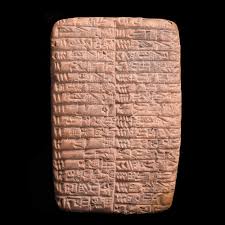From Clay Tablets to Consumer Insights: The Origins of Written Language
7th April 2025

Long before online surveys and data dashboards, humans found a way to capture, store and share information: writing. As market researchers, you are in the business of making sense of data to understand behaviour—something our ancestors began doing over 5,000 years ago, albeit with clay tablets and pictographs.
The story of written language is more than just a history lesson—it is the origin story of structured communication, data recording and the drive to organise human behaviour into patterns we can analyse.
Mesopotamia: Where Data Became Language
The earliest known form of writing emerged around 3200 BCE in Sumer, an ancient civilization in Mesopotamia (modern Iraq). This first script, cuneiform, was not invented for poetry or storytelling—it was created to track goods and transactions.
Sound familiar?
Sumerians used small clay tokens to represent commodities like grain, sheep and beer. Eventually, they began pressing these tokens into clay tablets and drawing standardised symbols. The system developed into wedge-shaped impressions made with a stylus—marking the birth of writing and, arguably, the first data records.
From these administrative needs came one of the world’s most complex and enduring writing systems, used to record everything from tax records to consumer goods.
Egypt: Symbolic Communication with Strategic Purpose
Shortly after cuneiform appeared, the Egyptians developed hieroglyphics—a highly visual, symbolic system used to convey religious and administrative information.
While hieroglyphs are often associated with tombs and temples, they were also tools of control and coordination across a vast empire. Think of them as the branding of their time—sophisticated messaging aligned with power, belief and identity.
Just like modern research must balance the analytical with the emotive, ancient Egypt shows how data and symbolism have always worked hand-in-hand to inform and influence.
The Indus Script: The Mystery of Missing Data
In the Indus Valley (modern Pakistan and northwest India), another ancient script emerged around 2600 BCE. Found on seals, tablets and pottery, the Indus script is still undeciphered.
Despite evidence of trade, urban planning and governance, we can not yet “read” what these people recorded. It is a sobering reminder: data without interpretation is just noise. And sometimes, our most meaningful insights remain just out of reach.
China: Continuity in Communication
China’s earliest known writing appears on oracle bones around 1200 BCE. These were used in ritual divinations, but they also recorded the questions and outcomes—early examples of hypothesis testing and archiving responses.
What is remarkable about Chinese writing is that it never stopped evolving. From oracle bones to today’s characters, it is a rare example of a writing system with continuous use for over 3,000 years—proof of the power of adaptive communication systems, much like the tools we use in modern research to evolve with audiences.
Writing Was Born to Record—Just Like Market Research
At its core, writing was developed to solve a problem: how to organize, store and share information across time and space. From supply inventories to royal propaganda, the earliest writing systems were forms of structured insight—designed to help people make decisions.
Market research is a direct descendant of this tradition. Our tools may be digital and our focus consumer-centric, but our goals are strikingly similar: record behaviour, find patterns, generate meaning and guide action.
The Human Drive to Understand
Today, we track eye movements, purchase journeys and brand sentiment. Yet behind all the dashboards and metrics lies the same motivation that sparked cuneiform: a desire to understand what people want, do and believe.
The evolution of writing reminds us that data collection is not new—and that insight, when paired with communication, has always shaped society.
At Foreign Tongues, we explore how language—past, present and future—connects with industries like market research. Stay tuned as we continue unpacking the roots of communication and what they mean for insight professionals today.
